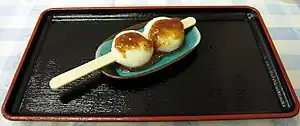Goheimochi
Goheimochi (Japanese: 五平餅) is a type of mochi made in the Chubu region of central Japan, specifically in Nagano, Gifu, and Aichi prefectures.[1] Unlike regular mochi it is coated with a type of sweet and sour sauce, usually composed of sugar, soy sauce, and mirin.[2] The mochi is then skewered and grilled. Goheimochi is typically made in one of two shapes: Waraji is shaped like a traditional sandal and rounded mochi is served on a skewer.[3] The mochi is usually only half-cooked so that some grains of rice remain, the rice is usually short-grain rice giving goheimochi a firmer texture compared to standard mochi.[4]

Varieties
Across the Chubu region there are many types of goheimochi. In the Kiso Valley and Hida region, goheimochi is often coated with soy sauce and sugar. In Aichi Prefecture, goheimochi is often covered in miso which is considered the region's specialty. Other examples of goheimochi sauce include honey, walnut, egg, and hachinoko (wasp larvae). Frozen goheimochi is now exported around Japan in vacuum sealed bags and can be found in supermarkets in Japan's larger cities.
History

Goheimochi was invented in the Edo Period,[5] though its origins are unknown. Despite this there are a few theories regarding the origins of the dish. As the name of the dish is similar to that of Gohei (Shinto streamers) many theorize that the reason the dish was created as a form of money that was offered to Shinto gods.[6] Another theory regarding the origins of the dish is that it came from the Japanese word for lumberjack "Gobei". Although goheimochi is most popular in Chubu since the release of NHK's Hanbun Aoi the dish has seen an increase in popularity all around the country, in Hanbun Aoi one of the main character starts a goheimochi stand around the end of the show.
Cultural references
In the TV series Hanbun, Aoi, one of the main characters opens a goheimochi shop. This feature increased the dish's popularity outside of Chubu. The film Your Name is set in the Hida Region and characters are seen eating goheimochi in various scenes.
See also
References
- "Gohei Mochi: Specialty Rice Cake of Nagano, Gifu, and Aichi - Recommendation of Unique Japanese Products and Culture". Retrieved 2021-11-13.
- "Gohei mochi (Gohei rice cake, 五平餅) What recipe? What sauce?". NAGANO TRIP. Retrieved 2021-11-14.
- "Goheimochi Rice Cake - Japanese Food". NHK WORLD. Retrieved 2021-11-13.
- "Goheimochi: A Uniquely Delicious Mochi Experience in Aichi - JAPANKURU". www.japankuru.com. Retrieved 2021-11-13.
- "Snacking on the Nakasendo | Kyoto Foodie: Where and what to eat in Kyoto". kyotofoodie.com. 2013-12-05. Retrieved 2021-11-14.
- "Food: The Gohei mochi in the Edo era". Discover a Japanese town full of ceramics, ceramic artists, wonderful local food and culture. Travel to us free - in VR!. Retrieved 2021-11-13.